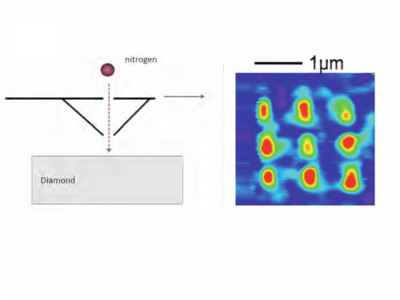WP-3
Spin qubits in Nitrogen Vacancy centres in diamond
Solid state quantum information devices working under ambient conditions is a very challenging goal. It is the aim of this work package to pave the way towards such devices based on spins in diamond. Based on existing 3 qubit devices, for the project period we are working to extend the number of qubits to 6 with the prospect of scaling towards larger units.

We investigate direct coupling between electrons spins, robust enough to allow room temperature operation with sufficient fidelity. Success requires reliable control over the environment as well as optimized read out and nanopositioning technology. Substantial progresses in materials design, nanotechnology and coherent control technique have brought us into a position where we can successfully address the above mentioned objectives. Most importantly the current state of the art in isotopically purified diamond materials achieves electron spin decoherenc times on the order of 4ms under ambient conditions. It is envisaged that two defect centre electrons spins will show coherent coupling in such an environment over a distance of roughly 50nm. Such a distance allows selective read-out and coherent control of individual spins. Addressing individual defect center by optical readout can be done with around 10nm accuracy, and a major effort will concern the controlled (less than 50 nm distance) implantation of defects in novel ultrapure diamond. In addition, diamond can be structured into almost any shape and size for integration into systems with more complex functionality. The ability to e.g. produce small nanocrystals or high quality photonic structures renders the system a viable candidate for hybrid systems being coupled, e.g. to superconducting qubits.
The workpackage is led by wrachtrup [at] physik [dot] uni-stuttgart [dot] de (subject: MESSAGE%20FROM%20SOLID%20WEBPAGE%20RE%3AWP-3) (Prof. Jörg Wrachtrup) of the Universität Stuttgart and progress is measured against the the following four milestones.
- M3.1 Create single color centers in diamond with depleted 13C concentration
- M3.2 Demonstrate coherent coupling between two defects separated by more than 20 nm
- M3.3 Evaluate coherence time and possibility to reach T1 limit for single spins in isotopically engineered diamond.
- M3.4 Robust deterministic entanglement for a small quantum register consisting of 4-8 spins in diamond.

